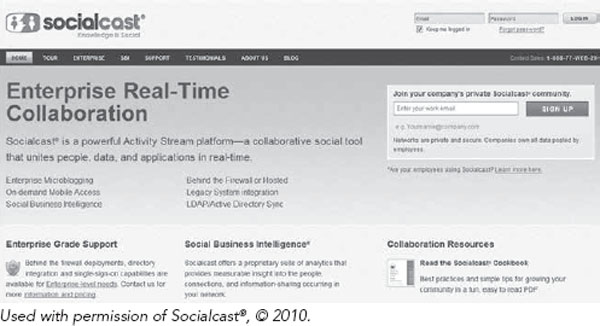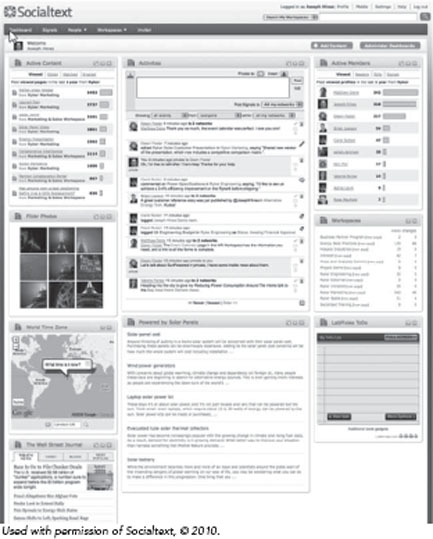STEP SIX
Launch the Social Networking Initiative
This book provides strategies and tactics for getting your organization onboard for social networking. Once you obtain support from the organization, you need to build workforce commitment to use and support the social networking efforts.
The complexity or ease of the launch depends on the type of social networking system your organization decided to implement. If you chose to leverage off-the-shelf social networking such as Facebook, Twitter, or other popular consumer applications, the effort is clearly less complex than the launch of a custom-built application on the scale of Starbucks' system or Dell's IdeaStorm.
Launching more complex social networking systems naturally involves more organizational players with proprietary interests that dictate you follow strict technology implementation guidelines. This more complex launch is not the focus of this step, but the general outline of a consumer-grade launch still has relevance for custom-built solutions.
Social Networking System Launch Plan
A formal launch plan is a project plan that describes the overall goal of the launch with explicit guidance on timelines, resources, roles and responsibilities, communication, risks, and mitigation. It ultimately acts as a blueprint for the sequence of events to get the social networking system adopted after it is enabled and ready to work in the organization's technological infrastructure. The launch plan can be created using a word-processing document, spreadsheet, project management application, graphics program, or even a wiki. The key parts of the launch plan are described as follows:
![]() Name—State the name of the launch plan (for example, North American Sales Social Networking Launch Plan).
Name—State the name of the launch plan (for example, North American Sales Social Networking Launch Plan).
![]() Objective—Describe the overall objective of the social networking system being launched, as well as the purpose and intent of the actual launch. The people (often the employees ultimately using the system) want to know what the system will do and why it is being deployed.
Objective—Describe the overall objective of the social networking system being launched, as well as the purpose and intent of the actual launch. The people (often the employees ultimately using the system) want to know what the system will do and why it is being deployed.
![]() Timeline—State the planned start and stop associated with the launch.
Timeline—State the planned start and stop associated with the launch.
![]() Roles and responsibilities—This section of the plan is used to describe the roles that will drive the launch as well as key responsibilities. This should include the name and title of the executive stakeholder, the launch team, and a description of what is expected for the target audience.
Roles and responsibilities—This section of the plan is used to describe the roles that will drive the launch as well as key responsibilities. This should include the name and title of the executive stakeholder, the launch team, and a description of what is expected for the target audience.
![]() Tasks—Describe the key tasks associated with the launch. These should be in the form of action-oriented, measurable activities and include planned start and stop dates and the resources that will complete them. Example tasks in a launch plan for social networking systems might include creating a communication plan, developing a training plan, and creating a governance model.
Tasks—Describe the key tasks associated with the launch. These should be in the form of action-oriented, measurable activities and include planned start and stop dates and the resources that will complete them. Example tasks in a launch plan for social networking systems might include creating a communication plan, developing a training plan, and creating a governance model.
![]() Milestones—List the key milestones for the launch. Milestones for a social networking system launch might include
Milestones—List the key milestones for the launch. Milestones for a social networking system launch might include
• project kick-off held
• final project plan developed
• communication plan developed (discussed in detail in the previous step)
• governance model developed
• adoption plan developed
• pilot (if one will be used) planned.
![]() Adoption plan—Include a discussion of how the social networking system will be adopted as broadly as possible in the organization. Are there social networking system moderators? Will there be incentives for using the system? How will new members learn the full functionality of the system?
Adoption plan—Include a discussion of how the social networking system will be adopted as broadly as possible in the organization. Are there social networking system moderators? Will there be incentives for using the system? How will new members learn the full functionality of the system?
Communication Plan
A new technology-enabled system offering functionality or features not familiar to your company's workforce presents change and communication challenges. Worksheet 5.1 provides a month-by-month schedule to help address this challenge (see Step 5).
Launch Plan Success Factors
How will you be able to demonstrate to the executive sponsorship team that the launch was clearly a success? You can use metrics or other indicators, such as total number of member profiles established, time on the social networking system per user, solutions created based on questions from the user base, and so on. Step 7 will describe more specific examples of success factors and measures for social networking systems. See Worksheet 6.1 for a launch plan template.
Launching a System
Some social networking systems are designed only for internal audiences, while others focus on external clients and customers. Still other systems support both internal and external audiences. The following are some specific examples of all three types of social networking systems.
WORKSHEET 6.1
Launch Plan Template
Instructions: Complete the worksheet below. This information will be the basis for your organization's launch plan.
Launch plan name___________________________________________
__________________________________________________________
Objectives_________________________________________________
__________________________________________________________
Timeline___________________________________________________
__________________________________________________________
Roles and responsibilities_____________________________________
__________________________________________________________
Tasks_____________________________________________________
__________________________________________________________
Milestones_________________________________________________
__________________________________________________________
Status meeting guidelines_____________________________________
__________________________________________________________
Adoption plan______________________________________________
__________________________________________________________
Communication plan_________________________________________
__________________________________________________________
Launch plan success factors____________________________________
__________________________________________________________
Internally Focused Social Networking Systems
Internal social networking drives collaboration and just-in-time knowledge sharing and is a powerful catalyst for informal learning in organizations. They can be as easy to set up as establishing a Facebook or Gmail account. However, just because an application is easy to access and set up does not necessarily mean you should skip thinking through and planning for the launch of these simple, yet powerful systems. Following are several examples of these systems.
![]() Yammer (www.yammer.com) is a Twitter-like social networking system that enables companies and organizations with the same email domain to establish internally focused social networking. Users can share status of projects, create sub-groups, rate posts, and even follow others signed up to the system (see Figure 6.1).
Yammer (www.yammer.com) is a Twitter-like social networking system that enables companies and organizations with the same email domain to establish internally focused social networking. Users can share status of projects, create sub-groups, rate posts, and even follow others signed up to the system (see Figure 6.1).
![]() Present.ly (www.presentlyapp.com) is another internally focused collaboration system that operates much like Yammer.
Present.ly (www.presentlyapp.com) is another internally focused collaboration system that operates much like Yammer.
FIGURE 6.1
Yammer Home Page

![]() Socialcast (www.socialcast.com) provides some of the same functionality as Yammer and Present.ly. However, it is a microblogging platform designed with a focus on the enterprise. It can integrate with many of an organization's legacy systems like SharePoint and Outlook, and can even socialize data from other company databases like client relationship management systems (CRMs), and so forth (see Figure 6.2).
Socialcast (www.socialcast.com) provides some of the same functionality as Yammer and Present.ly. However, it is a microblogging platform designed with a focus on the enterprise. It can integrate with many of an organization's legacy systems like SharePoint and Outlook, and can even socialize data from other company databases like client relationship management systems (CRMs), and so forth (see Figure 6.2).
![]() Socialtext (www.socialtext.com) is similar to the other previously mentioned systems; however, this system has some additional features, such as social connectivity (knowing who people are and their capabilities), wiki workspaces, blogs, and such. The system can be used for internal purposes, but also has an extranet feature that can be used for trusted partners and others (see Figures 6.3 and 6.4).
Socialtext (www.socialtext.com) is similar to the other previously mentioned systems; however, this system has some additional features, such as social connectivity (knowing who people are and their capabilities), wiki workspaces, blogs, and such. The system can be used for internal purposes, but also has an extranet feature that can be used for trusted partners and others (see Figures 6.3 and 6.4).
More Complex Launches
While many companies find great value in off-the-shelf applications, other larger businesses choose to launch more robust systems with additional business functionality or greater technological or security features. Companies such as Intel, Nike, British Telecom, Home Depot, UPS, Graco, Cisco, Kaiser Permanente, Walmart, and Google all have extensive internal social networking systems. Implementing these kinds of systems requires a more systematic approach and is more time consuming and costly (see sidebar on the following page for an example).
FIGURE 6.2
Socialcast Home Page

FIGURE 6.3
Socialtext Dashboard

A Model Internal Networking System
Sabre Holdings, the company that owns Travelocity, Sabre Travel Network, and Sabre Airline Solutions, created an interdepartmental social networking tool for its 10,000 employees located in 59 countries. The system, called SabreTown, connects employees from around the world. The platform driving the system is cubeless (www.cubeless.com; see Figures 6.5 and 6.6). When an employee first uses SabreTown, he or she creates a profile that captures interests, expertise, and other personal information. The user tags are created from questions such as
![]() What's your hometown?
What's your hometown?
![]() Where do you live now?
Where do you live now?
![]() What do you really do for a living?
What do you really do for a living?
![]() What are your corporate gigs and contacts?
What are your corporate gigs and contacts?
![]() What are your skills, expertise, or things you rule in?
What are your skills, expertise, or things you rule in?
![]() What is your favorite lunch spot or watering hole?
What is your favorite lunch spot or watering hole?
![]() What are the sports you can't live without?
What are the sports you can't live without?
![]() What are your favorite hobbies?
What are your favorite hobbies?
![]() What's the music you put on continuous repeat?
What's the music you put on continuous repeat?
![]() Which celebrity do you resemble?
Which celebrity do you resemble?
![]() Where have you traveled?
Where have you traveled?
![]() What places do you dream about going to?
What places do you dream about going to?
FIGURE 6.4
Socialtext Desktop

FIGURE 6.5
SabreTown Profile Page

Using the Sabre Information
The purpose of this information is to help the system migrate information out to those who are likely to be most interested in it. For example, when an employee submits a question through the online bulletin board, the system's predictive modeling searches the most relevant tags and sends questions to those with the most relevant profile. For example, if a question is posed on the Sabre system related to a specific software application, such as Microsoft Excel, then the question will be routed to those in the system who have identified themselves as having expertise in Microsoft Excel or those who describe it as part of their actual role in the company. This means specific questions aren't distributed to people who are not likely to have the answers.
Was the investment worth it? The general manager of Sabre Holdings' cubeless, Erik Johnson, notes that the system produced more than $500,000 in direct savings the first year through information dissemination efficiencies and other operational improvements. “But,” Johnson added, “we also know, based on anecdotal results, that figure doesn't come close to the representing the total savings we are finding from the system.”
FIGURE 6.6
SabreTown Questions and Answers Page

A key part of the launch plan is the adoption plan, and you can see that many of the best practices from the SabreTown launch discussed earlier might become an integral part of driving adoption. One of the greatest values of these systems is the dynamic just-in-time sharing of information; however, if employees aren't using the system, it is hard to realize its maximum value.
Externally Focused Social Networking Systems
Many companies use social networking systems to connect with their customers and to create friendly and inviting corporate identities.
Best Buy ran a national television advertising campaign to inform customers about Twelpforce (see Figure 6.7), a Twitter-based customer connection and communication system. Hundreds of Best Buy employees monitored tweets that included questions about products, services, offerings, and customer-care-related issues. The effort garnered more than 12,500 followers on Twitter. Of course, like most large companies, Best Buy communicates this new offering across multiple channels, including Twitter, television, Facebook, and YouTube.
FIGURE 6.7
Best Buy Twelpforce on Twitter

POINTER
This externally focused social networking system effort took thoughtful planning to ensure launch success. Because the system provides direct communication with Best Buy employees and their customers (and potential customers), launching this system without a plan could have been disastrous.
Internally and Externally Focused Social Networking Systems
Zappos.com is an example of a company that leverages its social networking systems for both internal and external audiences (recruiting, culture messaging, product discussion, customer feedback, and so on) across multiple social networking systems (see http://blogs.zappos.com). The launch of these dual-function systems requires the same communication and change management plans as any other system, large or small.
POINTER
Zappos leverages what can best be described as a “social networking surround.” It uses multiple channels for social networking systems as described in Step 2, which are meant to be used for communication within the organization as well as externally. Again, given the complexity of the social networking system offerings, the messaging, and the necessary integration of the social networking matrix Zappos uses, it is hard to imagine this could be done without a thoughtful launch plan.
Summary
In this step, the key elements of a successful launch were discussed, including the importance of change management and leveraging a communication plan. Some of the key differences in launches for internally, externally, and both internally and externally focused social networking systems were also discussed.
Step 7 will review ways to identify and leverage small successes with social networking to enable larger-scale change and benefit to the company.

